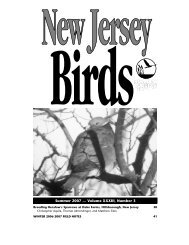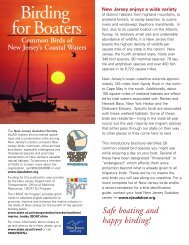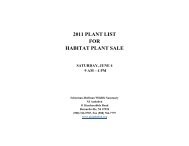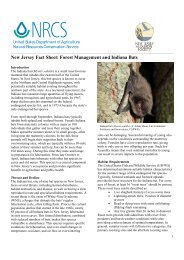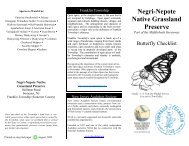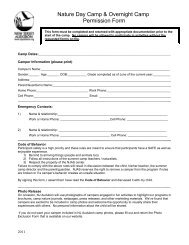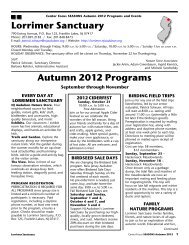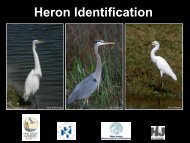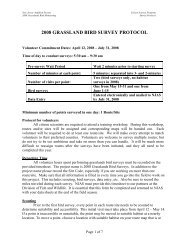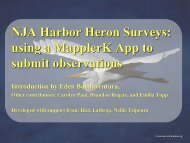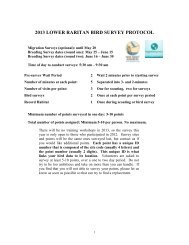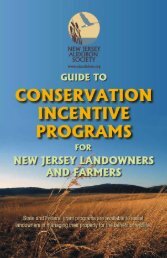2013 Gardening for Wildlife Workshops - Pat and Clay Sutton
2013 Gardening for Wildlife Workshops - Pat and Clay Sutton
2013 Gardening for Wildlife Workshops - Pat and Clay Sutton
You also want an ePaper? Increase the reach of your titles
YUMPU automatically turns print PDFs into web optimized ePapers that Google loves.
“<strong>2013</strong> <strong>Gardening</strong> <strong>for</strong> <strong>Wildlife</strong> <strong>Workshops</strong>"<br />
with NJ Audubon’s Nature Center of Cape May<br />
1600 Delaware Ave., Cape May, NJ 08204; (609)898-8848<br />
www.njaudubon.org/Centers/NCCM/<br />
GARDENING FOR WILDLIFE WORKSHOPS<br />
with <strong>Pat</strong> <strong>Sutton</strong> (backyard habitat educator <strong>for</strong> over 30 years)<br />
Saturday, March 2, <strong>2013</strong> – How to Create a Backyard Habitat <strong>for</strong> <strong>Wildlife</strong><br />
Sunday, March 3, <strong>2013</strong> – How to Create a Pollinator Garden<br />
(<strong>for</strong> Butterflies, Hummingbirds, Moths, Bees, & More)<br />
Saturday, March 9, <strong>2013</strong> – How to Create a Wildflower Meadow & <strong>Wildlife</strong> Pond<br />
Saturday, March 16, <strong>2013</strong> – Battlestar Backyardia – Battling the Alien Invaders<br />
(How to Recognize <strong>and</strong> Deal With Invasive Species)<br />
Saturday, March 23, <strong>2013</strong> – L<strong>and</strong>scape Design With <strong>Wildlife</strong> In Mind<br />
10:00 a.m. to 3:00 p.m.<br />
<strong>Pat</strong> <strong>Sutton</strong> has keenly studied the natural world <strong>for</strong> over thirty years. As an experienced<br />
naturalist <strong>and</strong> educator she will share her wildlife gardening expertise in this series of five<br />
workshops <strong>for</strong> property owners. These in-depth, all-day, fact-filled, <strong>and</strong> enlightening workshops<br />
will be site-specific to your own situation. Native plants <strong>and</strong> wildlife-friendly practices are the<br />
key <strong>and</strong> will be emphasized <strong>and</strong> detailed throughout. Valuable h<strong>and</strong>outs will be shared. These<br />
workshops have been scheduled <strong>for</strong> early spring, the perfect time to shake off winter <strong>and</strong> begin<br />
planning <strong>and</strong> planting (or enhancing) wildlife gardens. The first workshop is the backbone of<br />
the series (try not to miss it) <strong>and</strong> will supply a good foundation <strong>for</strong> the following sessions. The<br />
last workshop (L<strong>and</strong>scape Design) builds on the foundation of the other four workshops (so is<br />
best taken in conjunction with them). Each workshop will build on the last (but can also st<strong>and</strong><br />
alone) <strong>and</strong> will include question-<strong>and</strong>-answer sessions, a working lunch where participants will<br />
have the opportunity to discuss their own property, <strong>and</strong> a site visit to a nearby backyard habitat to<br />
rein<strong>for</strong>ce wildlife friendly practices <strong>and</strong> design <strong>and</strong> plant selection options.<br />
Where: The March 2, 3, 9, & 16 workshops will be held at the Cape May Bird Observatory Center <strong>for</strong><br />
Research & Education, 600 Rt. 47 N, Cape May Court House, NJ 08210 (<strong>and</strong> include a site visit to<br />
<strong>Sutton</strong>'s nearby wildlife gardens). The March 23 workshop will be held at the Nature Center of Cape<br />
May, 1600 Delaware Ave., Cape May, NJ 08204 (<strong>and</strong> include a site visit to a Cape May wildlife garden).<br />
Limit: 30 participants; preregistration is required (through Nature Center of Cape May,1600 Delaware<br />
Ave., Cape May, NJ 08204; 609-898-8848).<br />
Cost/workshop: $35 member of NJ Audubon Society, $45 nonmember (includes h<strong>and</strong>outs).<br />
Sign up <strong>for</strong> all five workshops <strong>for</strong> a discount: $125 member, $150 nonmember.<br />
– OVER <strong>for</strong> additional details --
<strong>Pat</strong>ricia <strong>Sutton</strong><br />
Backyard Habitat educator <strong>for</strong> over 30 years<br />
129 Bucks Avenue, Cape May Court House, NJ 08210<br />
patclaysutton@comcast.net<br />
<strong>2013</strong> GARDENING FOR WILDLIFE WORKSHOPS with <strong>Pat</strong> <strong>Sutton</strong><br />
through NJ Audubon's Nature Center of Cape May, 1600 Delaware Ave, Cape May, NJ 08204 (609-898-8848)<br />
Saturday, March 2 – How to Create a Backyard<br />
Habitat <strong>for</strong> <strong>Wildlife</strong> – 10:00 a.m. to 3:00 p.m.<br />
In the “Go Green” movement, all too often yards are <strong>for</strong>gotten; in fact,<br />
many yards are the antithesis of green. The first <strong>and</strong> most important step<br />
is to “Go Native,” to favor native plants <strong>and</strong> wildlife-friendly practices.<br />
<strong>Pat</strong> <strong>Sutton</strong> will showcase native trees, shrubs, vines, wildflowers, <strong>and</strong><br />
even weeds that are most beneficial to birds <strong>and</strong> other wildlife. From<br />
the perspective of a life-long naturalist intimate with the workings of the<br />
natural world, <strong>Sutton</strong> will share countless common-sense garden<br />
maintenance techniques that will help property owners avoid common<br />
practices that actually harm rather than benefit wildlife. In addition to<br />
the obvious (bird feeders, bird houses, <strong>and</strong> bird baths), this program is<br />
packed with the "how’s <strong>and</strong> why’s" of attracting birds, butterflies,<br />
dragonflies, <strong>and</strong> other wildlife to your backyard, no matter how small.<br />
(This workshop is the backbone of the series; try not to miss it).<br />
Sunday, March 3 – How to Create a Pollinator<br />
Garden (<strong>for</strong> Butterflies, Hummingbirds, Moths,<br />
Bees, <strong>and</strong> More) – 10:00 a.m. to 3:00 p.m.<br />
<strong>Pat</strong> <strong>Sutton</strong> will cover the basic “how to’s” <strong>for</strong> creating a<br />
pollinator-friendly garden <strong>and</strong> yard that will attract <strong>and</strong> benefit<br />
butterflies, hummingbirds, moths, bees <strong>and</strong> more! It is often as simply<br />
as planting Sweet Pepperbush instead of Crape Myrtle or planting<br />
Joe-pye-weed, Purple Coneflower, New Engl<strong>and</strong> Aster, <strong>and</strong> Goldenrod<br />
rather than Marigolds. Double the size of a parsley patch <strong>and</strong> be<br />
amazed by all the Black Swallowtails it attracts. Meet all the needs of<br />
hummingbirds <strong>and</strong> be dazzled by them in your gardens from late April<br />
through early October. The obvious, such as good nectar plants <strong>and</strong><br />
their blooming periods, will be covered, along with the not so obvious,<br />
such as the caterpillar food plants butterflies <strong>and</strong> moths need <strong>for</strong> egg<br />
laying, “mud puddling,” <strong>and</strong> the importance of proper cover from wind<br />
<strong>and</strong> weather. The mystery of a butterfly’s life cycle <strong>and</strong> where <strong>and</strong> how<br />
butterflies <strong>and</strong> moths spend the winter will be explained. Where<br />
hummingbirds go in winter, why they leave us when our gardens are still<br />
in bloom, when to have your yard ready <strong>for</strong> them in spring upon their<br />
return, hummingbird feeder maintenance, <strong>and</strong> lots of other fun natural<br />
history facts will be shared. The program features eye-c<strong>and</strong>y wildlife<br />
gardens in South Jersey that have successfully trans<strong>for</strong>med ho-hum<br />
backyards into multi-dimensional gardens full of life.<br />
Saturday, March 9 – How to Create a Wildflower<br />
Meadow & <strong>Wildlife</strong> Pond – 10:00 a.m. to 3:00 p.m.<br />
MEADOW – Learn how to enhance your backyard<br />
l<strong>and</strong>scaping <strong>for</strong> wildlife by creating a wildflower meadow. Many areas<br />
have lost their meadows to subdivisions <strong>and</strong> corporate headquarters<br />
l<strong>and</strong>scaped with acres <strong>and</strong> acres of sod lawn – monocultures that are<br />
green deserts <strong>for</strong> wildlife, offering no cover, no food (nectar, seeds,<br />
etc.), <strong>and</strong> no beauty (blooming wildflowers <strong>and</strong> lovely native grasses).<br />
Clouds of butterflies <strong>and</strong> nesting bluebirds can still be found where<br />
meadows abound. If you (or your corporate headquarters) have more<br />
lawn than you need <strong>and</strong> mowing gobbles up precious time <strong>and</strong><br />
expensive gas, consider turning some of this lawn into a wildflower<br />
meadow. Even a small meadow will make a big difference to wildlife. A<br />
meadow can be simple to create <strong>and</strong> <strong>Pat</strong> <strong>Sutton</strong> will share the basics.<br />
Learn how to convert lawn to meadow, how to maintain your meadow in<br />
a simple fashion over time, <strong>and</strong> how to make it acceptable <strong>and</strong> attractive<br />
to neighbors <strong>and</strong> visitors.<br />
NO-FUSS WILDLIFE POND – Frogs, toads, <strong>and</strong> dragonflies<br />
all need freshwater ponds <strong>for</strong> egg laying to create future generations.<br />
Even a tiny pond will attract <strong>and</strong> support them. Learn what a true<br />
wildlife pond is <strong>and</strong> how simple it is to create – with no need <strong>for</strong><br />
running water, filters, fish, <strong>and</strong> all the fuss. <strong>Pat</strong> <strong>Sutton</strong> will share the<br />
basics of how to create a wildlife pond <strong>and</strong>, even more importantly, how<br />
to maintain it so that wildlife benefits. Learn which native plants to add<br />
to the pond (<strong>and</strong> which problem plants to avoid), <strong>and</strong> don't be surprised<br />
if <strong>Sutton</strong> offers to share native plants from her very own ponds. Don't<br />
make the same mistake that others have made by creating a pond <strong>for</strong><br />
exotic fish that supports little else. In a true wildlife pond, expect to<br />
attract <strong>and</strong> get to watch the amazing life cycle of huge Green Darner<br />
dragonflies or count a growing population of Leopard Frogs <strong>and</strong> Green<br />
Frogs that find your pond as if by magic. Create it <strong>and</strong> they will come!<br />
Saturday, March 16 – Battlestar Backyardia –<br />
Battling the Alien Invaders – How to deal with<br />
invasive species – 10:00 a.m. to 3:00 p.m.<br />
Many people are surprised to learn that plants they'd assumed were<br />
native are in fact non-native, problem plants. Many gardeners are<br />
unaware of the far-reaching damage they can do when they plant<br />
invasives like Periwinkle (Vinca), English Ivy, <strong>and</strong> bamboo. In a very<br />
short time these plants might invade the neighbor’s yard, properties<br />
across the street <strong>and</strong> down the street, <strong>and</strong> even nearby preserves. The<br />
invasion of non-natives has taken a big toll on butterflies <strong>and</strong> moths<br />
(that need native plants to lay their eggs on) <strong>and</strong> insect-eating birds<br />
looking <strong>for</strong> butterfly <strong>and</strong> moth caterpillars. Sadly, most nurseries<br />
contribute heavily to this problem by offering <strong>for</strong> sale many known<br />
culprits, plants that are outlawed in surrounding states <strong>and</strong> plants that<br />
the State of New Jersey is spending enormous amounts of money to<br />
control <strong>and</strong> remove from natural areas. Purple Loosestrife is just one<br />
example. Most shoppers assume that nurseries are acting responsibly,<br />
but the wise gardener needs to be educated to recognize invasives<br />
because the nursery trade has a deep-rooted love affair with exotic<br />
plants. This program will address key invasive plants, help you learn<br />
how to identify them, offer suggestions on how to control or remove<br />
them if they find their way into your garden, <strong>and</strong> showcase lovely native<br />
alternatives.<br />
Saturday, March 23 – L<strong>and</strong>scape Design With<br />
<strong>Wildlife</strong> in Mind – 10:00 a.m. to 3:00 p.m.<br />
<strong>Sutton</strong> will emphasize designs that work with nature, not at odds with<br />
nature. Choosing the right plant <strong>for</strong> the right spot (<strong>and</strong> the right site <strong>for</strong><br />
key elements of a wildlife habitat) is key. The program will showcase<br />
multi-dimensional, diverse, layered, <strong>and</strong> interesting-to-the-eye natural<br />
l<strong>and</strong>scapes that benefit wildlife, emphasizing to “let nature be the<br />
guide.” Typical l<strong>and</strong>scaping (lawn <strong>and</strong> uni<strong>for</strong>m park-like plantings) will<br />
pale in comparison. (This workshop is the last in the series of <strong>Sutton</strong>’s<br />
in-depth, content-filled gardening <strong>for</strong> wildlife workshops <strong>and</strong> builds on<br />
the foudation of the other workshops.)<br />
Limit/workshop: 30 participants; Preregistration is required<br />
Cost/workshop: $35 member of NJ Audubon Society<br />
$45 nonmember (includes h<strong>and</strong>outs).<br />
Sign up <strong>for</strong> all five workshops <strong>for</strong> a discount:<br />
$125 member, $150 nonmember.



